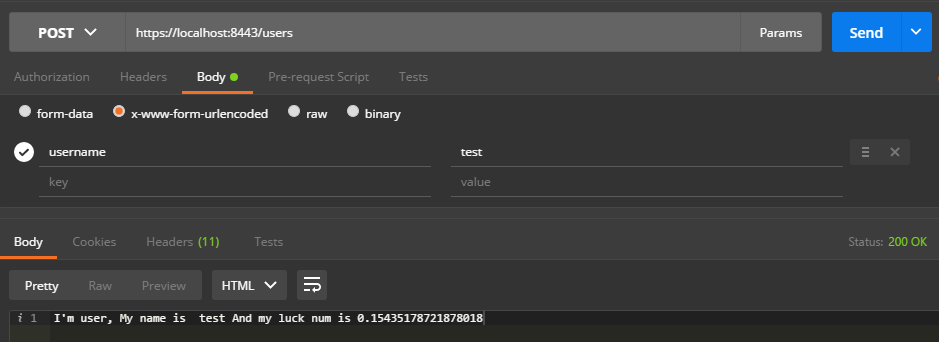重定向Http status code 303 和 302
2016-09-08 23:20
323 查看
http 302
http 303
Example
Client request:
GET /index.html HTTP/1.1
Host: www.example.com
Server response:
当我请求list的时候,跳转到users,来获取所有的用户。
当时用浏览器访问的时候,会明显的看到浏览器地址变了,也就是说我明明请求的是list,结果你给我变成了users。然而,由于浏览器帮我们做了跳转的工作,我们感觉不出来,但从地址栏还是可以看到的。
查看
通过拦截请求可以看出来,访问了两次:

并且list是302,而users是200.也就是说list进行了重定向。再来看list的response:
最关键的就是location:
redirect的另一个作用是原请求的内容将会被舍弃,即如果是post请求,redirect的时候默认是不带参数的。与之相对应的forward的请求是转发,只有一次请求,并且带body转发过去。
Example
Client request:
POST / HTTP/1.1
Host: www.example.com
Server response:
发送

查看拦截

可以看到,post的时候返回303,并且在返回的response的header中添加了:
Location: /users/test
所以see other的意思就是去别的地方看看。值得注意的是,如果返回303,但是没有添加location,那么只会查看一条请求303.而在httpclient的默认处理中,这时候会抛出exception:location not found。
维基百科 http 303
http 303
Http 302
302是一个普通的重定向代码。直观的看来是,请求者(浏览器或者模拟http请求)发起一个请求,然后服务端重定向到另一个地址。而事实上,服务端仅仅是增加一条属性到header,location=重定向地址。而一般的,浏览器会自动的再去请求这个location,重新获取资源。也就是说,这个会使得浏览器发起两次请求。Example
Client request:
GET /index.html HTTP/1.1
Host: www.example.com
Server response:
实验
首先,我们用一个Map来存储信息,key为username,value为随机数。当我请求list的时候,跳转到users,来获取所有的用户。
Map<String, Double> users = new HashMap<>();
@RequestMapping(value = "/list", method = RequestMethod.GET)
public String index(){
return "redirect:/users";
}
@ResponseBody
@RequestMapping(value = "/users", method = RequestMethod.GET)
public ResponseEntity getUsers(){
ResponseEntity responseEntity = new ResponseEntity(users, HttpStatus.OK);
return responseEntity;
}当时用浏览器访问的时候,会明显的看到浏览器地址变了,也就是说我明明请求的是list,结果你给我变成了users。然而,由于浏览器帮我们做了跳转的工作,我们感觉不出来,但从地址栏还是可以看到的。
查看
通过拦截请求可以看出来,访问了两次:

并且list是302,而users是200.也就是说list进行了重定向。再来看list的response:
Request URL:https://localhost:8443/list Request Method:GET Status Code:302 Remote Address:127.0.0.1:8888 Response Headers view source Cache-Control:no-cache, no-store, max-age=0, must-revalidate Content-Language:zh-CN Content-Length:0 Date:Thu, 08 Sep 2016 14:31:33 GMT Expires:0 Location:https://localhost:8443/users Pragma:no-cache Strict-Transport-Security:max-age=31536000 ; includeSubDomains X-Application-Context:application:dev:8443 X-Content-Type-Options:nosniff X-Frame-Options:DENY X-XSS-Protection:1; mode=block Request Headers view source Accept:text/html,application/xhtml+xml,application/xml;q=0.9,image/webp,*/*;q=0.8 Accept-Encoding:gzip, deflate, sdch, br Accept-Language:zh-CN,zh;q=0.8 Authorization:Basic YWRtaW46dGVzdA== Connection:keep-alive Host:localhost:8443 Upgrade-Insecure-Requests:1 User-Agent:Mozilla/5.0 (Windows NT 10.0; WOW64) AppleWebKit/537.36 (KHTML, like Gecko) Chrome/52.0.2743.82 Safari/537.36
最关键的就是location:
Request URL:https://localhost:8443/users Request Method:GET Status Code:200 Remote Address:127.0.0.1:8888 **Response Headers** view source Cache-Control:no-cache, no-store, max-age=0, must-revalidate Content-Type:application/json;charset=UTF-8 Date:Thu, 08 Sep 2016 14:31:33 GMT Expires:0 Pragma:no-cache Strict-Transport-Security:max-age=31536000 ; includeSubDomains Transfer-Encoding:chunked X-Application-Context:application:dev:8443 X-Content-Type-Options:nosniff X-Frame-Options:DENY X-XSS-Protection:1; mode=block **Request Headers** view source Accept:text/html,application/xhtml+xml,application/xml;q=0.9,image/webp,*/*;q=0.8 Accept-Encoding:gzip, deflate, sdch, br Accept-Language:zh-CN,zh;q=0.8 Authorization:Basic YWRtaW46dGVzdA== Connection:keep-alive Host:localhost:8443 Upgrade-Insecure-Requests:1 User-Agent:Mozilla/5.0 (Windows NT 10.0; WOW64) AppleWebKit/537.36 (KHTML, like Gecko) Chrome/52.0.2743.82 Safari/537.36
redirect的另一个作用是原请求的内容将会被舍弃,即如果是post请求,redirect的时候默认是不带参数的。与之相对应的forward的请求是转发,只有一次请求,并且带body转发过去。
Http 303
303 See Other。通常是指所请求的资源在别的地方,并且同302一样,会在header中的location标明资源的位置。在我的一个是使用过程中,我想要创建一个user,当关于这个user的key已经存在的时候,server将返回303,并且告之这个user的获取位置。Example
Client request:
POST / HTTP/1.1
Host: www.example.com
Server response:
实验
我将要发送post请求创建user,如果user已经存在则返回303Map<String, Double> users = new HashMap<>();
@ResponseBody
@RequestMapping(value = "/users", method = RequestMethod.POST)
public ResponseEntity createUser(String username){
Double luckNum = users.get(username);
if (luckNum ==null){
double random = Math.random();
users.put(username, random);
return new ResponseEntity(random,HttpStatus.OK);
}else{
MultiValueMap<String,String> headers = new HttpHeaders();
headers.add("Location", "/users/"+username);
return new ResponseEntity(luckNum, headers, HttpStatus.SEE_OTHER);
}
}
@ResponseBody
@RequestMapping(value = "/users/{username}", method = RequestMethod.GET)
public ResponseEntity getUser(@PathVariable("username") String username){
ResponseEntity responseEntity = new ResponseEntity("I'm user, My name is "+ username+ " And my luck num is "+users.get(username), HttpStatus.OK);
return responseEntity;
}发送

查看拦截

可以看到,post的时候返回303,并且在返回的response的header中添加了:
Location: /users/test
所以see other的意思就是去别的地方看看。值得注意的是,如果返回303,但是没有添加location,那么只会查看一条请求303.而在httpclient的默认处理中,这时候会抛出exception:location not found。
参考
维基百科 http 302维基百科 http 303
相关文章推荐
- 重定向Http status code 303 和 302
- Http请求 重定向 问题 responseCode:302
- HTTP 的重定向301,302,303,307
- http的重定向状态码302,303,307
- HTTP 的重定向301,302,303,307(转)
- 【HTTP】http重定向301/302/303/307
- HTTP 的重定向301,302,303,307(转)
- JSP学习笔记(二)------请求重定向与请求转发的区别及HTTP Status Code(HTTP状态码)整理说明
- HTTP 的重定向301,302,303,307(转)
- HTTP 的重定向301,302,303,307
- HttpPost链接解析网络服务器xml(response.getStatusLine().getStatusCode()==200链接成功)
- 常见的HTTP状态码(HTTP Status Code)说明
- HTTP Status Code
- HTTP 302, 303, 307
- nginx统计响应的http状态码信息(ngx-http-status-code-counter)
- HttpWebRequest.GetResponse() raises exception when http status code 400 (bad request) is returned
- HTTP协议状态码详解(HTTP Status Code)
- HTTP状态码一览表(HTTP Status Code)
- 常见的Http Status Code
- HTTP状态码->HTTP Status Code
